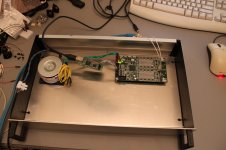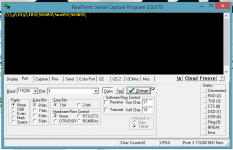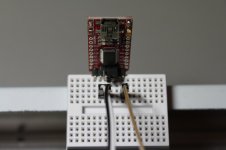And doesnt lock to any input.... gulp.
//
Remember to do a full power cycle. There are several checks in the file download, incl signatures and two levels of CRC checks. If it say downloaded and the size matches, then it should be ok, otherwise we need to investigate....
Used instead a laptop but same usb-serial dongle. Worked.
Is laptop running Windows?
Silence. Everyone is building
//
Yes!
My board finally arrived, but now waiting on the Amanero - at least it's now been sent 2 weeks after ordering and a week after it was marked as sent on my paypal account it is finally showed up as having been posted on the 29th.
I'd hacked an cheap XMOS -> SPDIF interface to use but after making some distorted sounds via the DAM1021 it's no longer recognised by any of my computers. Todays mission is to get SPDIF working so I can at least listen to the DAC.
Bevare of that if you drop the earth connection to your pot, you get full +15 dB out. It happend to me and expsed to 400 watts both my speakers are at the "doctor" 
I had taken out the dac and USB board a couple of times and the Cat6 TP cables just becane exhausted near a solder joint.
Happend wednesday evening. So no good sound for a numer of days.
So think about this and be careful.
//
I had taken out the dac and USB board a couple of times and the Cat6 TP cables just becane exhausted near a solder joint.
Happend wednesday evening. So no good sound for a numer of days.
So think about this and be careful.
//
If the USB-I2S doesn´t supply for the 3.3V and gnd, where to get the supply from .. . J2´s 3.3V and gnd? But then the isolators won´t be isolated any more.
This is already answered earlier in some of the threads - but it's getting hard to find with all the posts... if there is no 3.3v output from the source, then you have to use a separate psu to keep the isolation. Exactly as you said earlier, if using J2's 3.3v/gnd, then you break the isolation
Bevare of that if you drop the earth connection to your pot, you get full +15 dB out. It happend to me and expsed to 400 watts both my speakers are at the "doctor"
I had taken out the dac and USB board a couple of times and the Cat6 TP cables just becane exhausted near a solder joint.
Happend wednesday evening. So no good sound for a numer of days.
So think about this and be careful.
//
Damn, this is NOT fun.
And it is also the reason why i like analog pots/stepped attenuator/relay attenuator for volume. Then you always have control of the volume, after the source.
That's not funny at all..Bevare of that if you drop the earth connection to your pot, you get full +15 dB out. It happend to me and expsed to 400 watts both my speakers are at the "doctor"
I had taken out the dac and USB board a couple of times and the Cat6 TP cables just becane exhausted near a solder joint.
Happend wednesday evening. So no good sound for a numer of days.
So think about this and be careful.
//
Thanks for the warning. I agree with RollE2k about the analog pots.
Bevare of that if you drop the earth connection to your pot, you get full +15 dB out. It happend to me and expsed to 400 watts both my speakers are at the "doctor"
I had taken out the dac and USB board a couple of times and the Cat6 TP cables just becane exhausted near a solder joint.
Happend wednesday evening. So no good sound for a numer of days.
So think about this and be careful.
//
Oouch, sorry to hear that. But it could actually happen with any potmeter where you loses gnd.
The R-2R DAC actually have a little failsafe as it will not add gain until set at or below 0db first. But that just at power up, no protection against sudden problems.... But in contrary to an analog potmeter, I have a uC in control and will look into adding additional failsafe, one possibility is if potmeter goes up too fast it should be detected as error.
It's alive! 
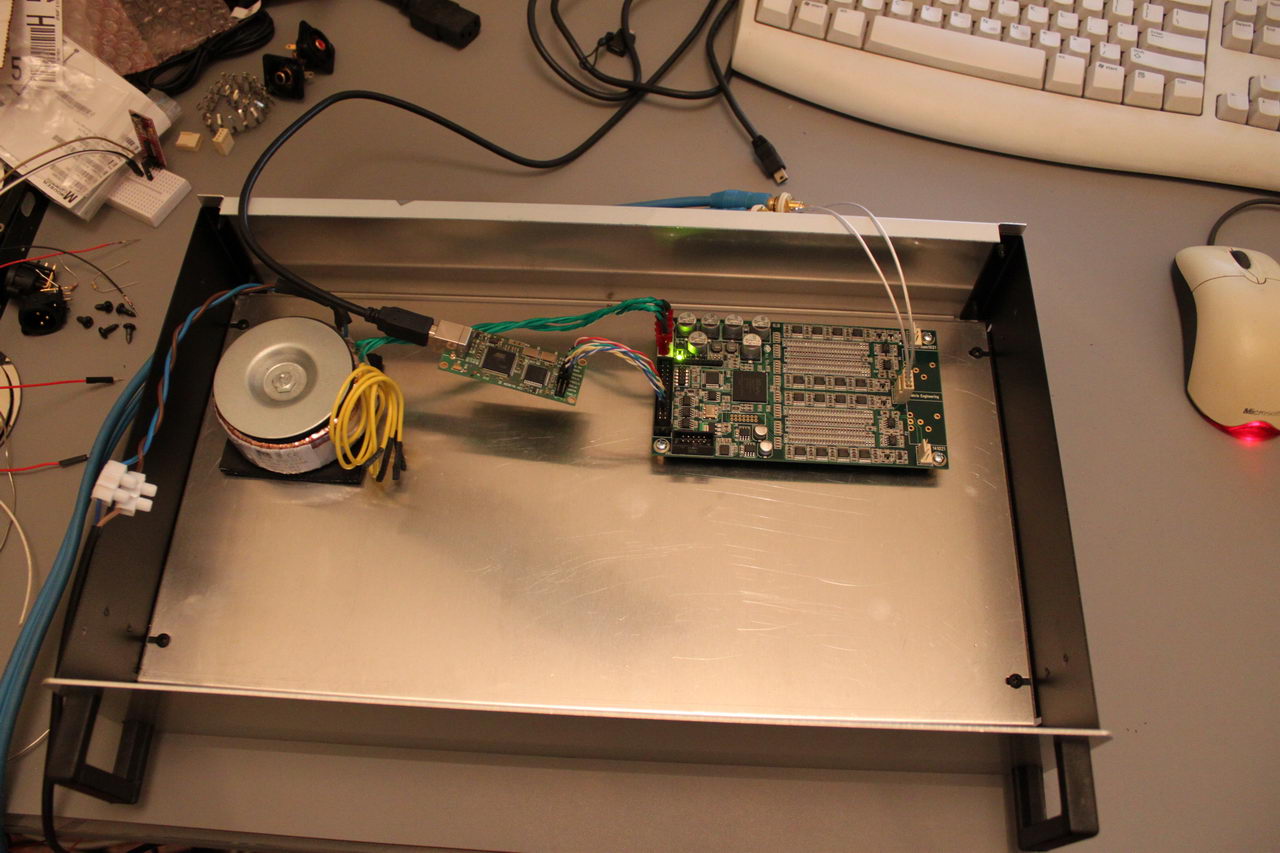
The ugly case is of course temporary..
Everything looks fine, except that I can not get the serial connection to display correctly on my machine. No matter what I do, I can't get anything intelligible out of it. All I get is this:
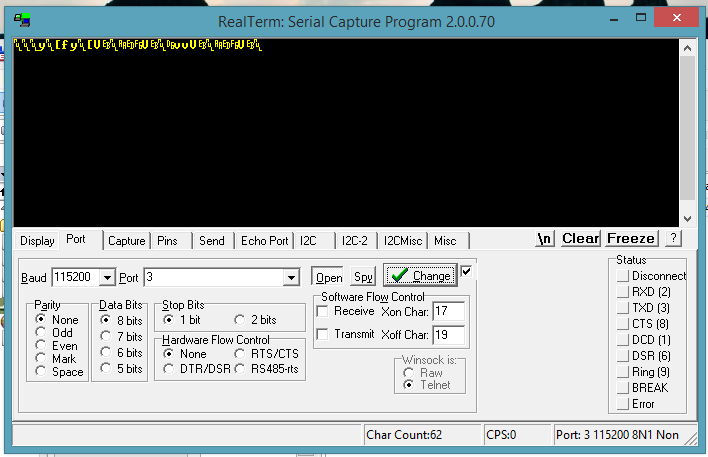
When I detach / re-attach the Amanero I get a few more "words" so I suspect that the serial connection is OK. I have tried as many different character sets as I could with no result.
I am obviously doing something wrong, I suspect in the software side.
I tried it in a second PC with the same results.
Any ideas?
The ugly case is of course temporary..
Everything looks fine, except that I can not get the serial connection to display correctly on my machine. No matter what I do, I can't get anything intelligible out of it. All I get is this:
When I detach / re-attach the Amanero I get a few more "words" so I suspect that the serial connection is OK. I have tried as many different character sets as I could with no result.
I am obviously doing something wrong, I suspect in the software side.
I tried it in a second PC with the same results.
Any ideas?
Attachments
115200 is kinda pretty fast for RS-232, make sure you have a good but not too long cable, and if using a USB-Serial dongle, check if it can actually run 115200.... Also, quality varies at lot between USB-Serial dongles.
Be aware that the serial port transceiver on the dam1021 R-2R DAC has power saving enabled, to reduce noise, it need valid RS-232 level on the RXD line to power up. If your USB-Serial dongle also have power saving then you have a problem....
Best is running directly to a real PC serial port, but those are getting rare nowadays....
Be aware that the serial port transceiver on the dam1021 R-2R DAC has power saving enabled, to reduce noise, it need valid RS-232 level on the RXD line to power up. If your USB-Serial dongle also have power saving then you have a problem....
Best is running directly to a real PC serial port, but those are getting rare nowadays....
115200 is kinda pretty fast for RS-232, make sure you have a good but not too long cable, and if using a USB-Serial dongle, check if it can actually run 115200.... Also, quality varies at lot between USB-Serial dongles.
I am using a pretty standard USB to serial interface with an FTDI chip:
I have used it with success in the past to connect to an Arduino at 115200, so it can do the speed. I am using a few centimeters of cable, so that is probably not the problem. But I am using 3.3V signalling, which (come to think of it..) might be a problem. Since you are suggesting a "classic" PC serial port I can assume that your port has no problem running at 5V or even more. I will try that.
Be aware that the serial port transceiver on the dam1021 R-2R DAC has power saving enabled, to reduce noise, it need valid RS-232 level on the RXD line to power up. If your USB-Serial dongle also have power saving then you have a problem....
I believe that the dam1021's serial port is powering up, since it is transmitting data, it's just that the data is either corrupt or is not recognised by my terminal software (I have tried 3 or 4 different ones, btw.. none of them worked).
Best is running directly to a real PC serial port, but those are getting rare nowadays....
That is so true. I took a look at my PCs (desktops and towers) and I found a real serial port on only one of them, an old mini-itx machine that I have stopped using years ago. If everything else fails, I'll try using that. It will be a last resort, since I will need to install Windows on it.
Attachments
I am using a pretty standard USB to serial interface with an FTDI chip:
I have used it with success in the past to connect to an Arduino at 115200, so it can do the speed. I am using a few centimeters of cable, so that is probably not the problem. But I am using 3.3V signalling, which (come to think of it..) might be a problem. Since you are suggesting a "classic" PC serial port I can assume that your port has no problem running at 5V or even more. I will try that.
The dam1021 serial port is at real RS-232 level, not 3.3V CMOS levels.... That might be the issue.
Got my setup running - turns out the distortion was a problem with the grounding in the preamp.
Currently running via Mac Mini -> Stello U3 -> SPDIF and controlling volume in Audirvana+. Doesn't sound as lush as the D1 clone (4 x PCM63 and JFET version of the Pass I/V stage) but very detailed and clean, with wide soundstage. I don't hear any harshness at all playing via Hypex UcD180HG + HxR amp, and Audiovector Mi1 Signature speakers.
Currently running via Mac Mini -> Stello U3 -> SPDIF and controlling volume in Audirvana+. Doesn't sound as lush as the D1 clone (4 x PCM63 and JFET version of the Pass I/V stage) but very detailed and clean, with wide soundstage. I don't hear any harshness at all playing via Hypex UcD180HG + HxR amp, and Audiovector Mi1 Signature speakers.
- Home
- Vendor's Bazaar
- Reference DAC Module - Discrete R-2R Sign Magnitude 24 bit 384 KHz
